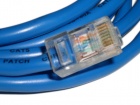Alternative Technologies for Ethernet
From Computing and Software Wiki
| (7 intermediate revisions not shown) | |||
| Line 68: | Line 68: | ||
| brown solid | | brown solid | ||
|} | |} | ||
| - | [http://en.wikipedia.org/wiki/Ethernet_crossover_cable#Crossover_cable_pinouts | + | [http://en.wikipedia.org/wiki/Ethernet_crossover_cable#Crossover_cable_pinouts] |
[[Image:cat5.jpg|thumb|140px|right| | [[Image:cat5.jpg|thumb|140px|right| | ||
| Line 80: | Line 80: | ||
=== Ethernet Through Power Lines === | === Ethernet Through Power Lines === | ||
Another alternatives on the horizon to provide support for Ethernet is using power lines and electrical distribution means to also distribute data. Through electrical signals This is a recent technology and has yet to be perfected, more information about it can be found in the External Links section. | Another alternatives on the horizon to provide support for Ethernet is using power lines and electrical distribution means to also distribute data. Through electrical signals This is a recent technology and has yet to be perfected, more information about it can be found in the External Links section. | ||
| + | |||
| + | [[Image:barbie.jpg|thumb|140px|right| | ||
| + | '''Magic Fairy Barbie''']] | ||
| + | === Barbie Magical Powder === | ||
| + | Although there is absolutely no evidence whatsoever to prove this theory, some people (and by some, none is implied) believe that an Ethernet can be sustained by Barbie's Magical Princess Powder, which comes from the valley of the cannabalistic sugarpop elves. These people (none) believe that this can sustain speeds of up to 1 kb/s, and create a strangely attractive presence to any connections that are established. | ||
== References == | == References == | ||
| Line 88: | Line 93: | ||
== See Also == | == See Also == | ||
| + | [http://www.cas.mcmaster.ca/wiki/index.php/Mesh_Networking "Mesh Networking"]<br> | ||
| + | [http://www.cas.mcmaster.ca/wiki/index.php/Network-Based_Software_Architectures "Network-Based Software Architectures"]<br> | ||
| + | [http://www.cas.mcmaster.ca/wiki/index.php/Computer_Network_Traffic_Shaping "Computer Network Traffic Shaping"]<br> | ||
== External Links == | == External Links == | ||
| Line 93: | Line 101: | ||
[http://en.wikipedia.org/wiki/Power_over_Ethernet "Power over Ethernet"] | [http://en.wikipedia.org/wiki/Power_over_Ethernet "Power over Ethernet"] | ||
<br> | <br> | ||
| + | |||
| + | --[[User:Cavaliaj|Cavaliaj]] 20:07, 12 April 2008 (EDT) | ||
Current revision as of 00:07, 13 April 2008
With its introduction in the early 1980s, Ethernet has been the predominant solution to local area networking all over the world. But with advances in technology and other countries exploring new options, it is only just now that many new alternatives to the standard approach of using the common twisted pair cables, are emerging. These kind of networks can be found anywhere, from a network in your house, to the network connecting all the computers in a school or business. However larger networks that do not consist of simple point to point connection would require many more hubs to bridge the connections between networked machines.
Contents |
Alternative Technologies for Ethernet
- Fiber Optic Cable
- Crossover Cable
- Faster Ethernet with Category 5/6 Cable
Use of Fiber Optic Cables
The basic premise behind fiber optic networking, is to send pulses of light through an optical fiber (A long wire of usually plastic or glass, that acts to guide light across its entire length)The obvious benefit to using light over electrical signals is speed, light can move a lot faster than any other form of signal. However the use of optical fiber cables does have many disadvantages, and is not necessarily the best option when it comes to ethernet. First and foremost, installing a Fiber Optic system can be extremely expensive and time consuming. Also, Fiber Optics are primarily most effective when being used over a large distance (ie. Cross continental) for privatized, high bandwidth applications. Due to these limitations, although Fiber Optics are better in some cases, as of now it is still much more cost, and resource, efficient to use other means of networking on a smaller scale.
Crossover Cables
Crossover cables were a means to avoid the need for a switch or hub/router. Acting and being almost identical to standard ethernet twisted pair cables, the only difference being that on one end of the cable the wire pairs are swapped in position 2 and 3. This allows for crossover cables to be used to directly connect two machines together without the need for any switch in between. Recently, however, crossover cables are quickly becoming obselete. With the release of network interface cards that are capable of doing the switch internally takes away the need for crossover cables, and standard twisted pair cables can be used to achieve the same result.
Standard Crossover cable pinouts
| Pin | Connection 1 pair | Connection 2 pair | Connection 1 | Connection 2 | |
|---|---|---|---|---|---|
| 1 | 3 | 2 | white/green stripe | white/orange stripe | |
| 2 | 3 | 2 | green solid | orange solid | |
| 3 | 2 | 3 | white/orange stripe | white/green stripe | |
| 4 | 1 | 1 | blue solid | blue solid | |
| 5 | 1 | 1 | white/blue stripe | white/blue stripe | |
| 6 | 2 | 3 | orange solid | green solid | |
| 7 | 4 | 4 | white/brown stripe | white/brown stripe | |
| 8 | 4 | 4 | brown solid | brown solid |
Cat5/6 Cables
The most typical means of ethernet today is by using category 5 patch cables (utilizing twisted pair copper wiring). It is extremely cheap to produce, making it the most readily available solution to setting up small scale networks. However the tradeoff for such versatility is a fairly low maximum transfer rate, usually reaching only around 100MB/s, and with many high bandwidth applications today requiring much more, alternative solutions are a necessity. Category 5 cables are typically unshielded to electrical and other forms of interference.
Category 6 cables are a fairly recently perfected alternative to the slow speed, twisted pair problem. Most Cat6 cables are used for Gigabit Ethernet, which as the name implies, provides speeds up to one gigabit per second. Just like its predecessor, it is typically unshielded. There are also Cat6 cables that can operate at up to 10 Gbits/s though many standard networking setups utilizing older hardware do not yet support it.
Ethernet Through Power Lines
Another alternatives on the horizon to provide support for Ethernet is using power lines and electrical distribution means to also distribute data. Through electrical signals This is a recent technology and has yet to be perfected, more information about it can be found in the External Links section.
Barbie Magical Powder
Although there is absolutely no evidence whatsoever to prove this theory, some people (and by some, none is implied) believe that an Ethernet can be sustained by Barbie's Magical Princess Powder, which comes from the valley of the cannabalistic sugarpop elves. These people (none) believe that this can sustain speeds of up to 1 kb/s, and create a strangely attractive presence to any connections that are established.
References
"Fiber Optic Communication"
"Ethernet Crossover Cable"
"Category 5 Cable"
"Category 6 Cable"
See Also
"Mesh Networking"
"Network-Based Software Architectures"
"Computer Network Traffic Shaping"
External Links
"Broadband over Power Lines"
"Power over Ethernet"
--Cavaliaj 20:07, 12 April 2008 (EDT)



